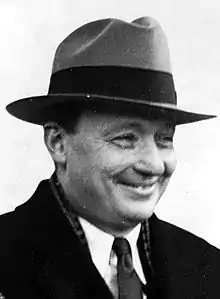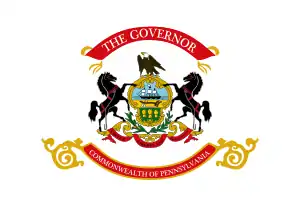George Howard Earle III
George Howard Earle III (December 5, 1890 – December 30, 1974) was an American politician and diplomat. He was a member of the prominent Earle family and the 30th Governor of Pennsylvania from 1935 to 1939. Earle was one of just two Democrats that served as Governor of Pennsylvania between the Civil War and World War II.
George Howard Earle III | |
|---|---|
 | |
| United States Ambassador to Bulgaria | |
| In office February 14, 1940 – April 2, 1940 | |
| President | Franklin Roosevelt |
| Preceded by | Ray Atherton |
| Succeeded by | Donald Heath |
| Member of the Democratic National Committee from Pennsylvania | |
| In office May 22, 1936[1] – February 21, 1940[2] | |
| Preceded by | Sedgwick Kistler |
| Succeeded by | David Lawrence |
| 30th Governor of Pennsylvania | |
| In office January 15, 1935 – January 17, 1939 | |
| Lieutenant | Thomas Kennedy |
| Preceded by | Gifford Pinchot |
| Succeeded by | Arthur James |
| United States Minister to Austria | |
| In office July 24, 1933 – March 25, 1934 | |
| President | Franklin Roosevelt |
| Preceded by | Gilchrist Baker Stockton |
| Succeeded by | George Messersmith |
| Personal details | |
| Born | George Hussey Earle III December 5, 1890 Devon, Pennsylvania, U.S. |
| Died | December 30, 1974 (aged 84) Bryn Mawr, Pennsylvania, U.S. |
| Political party | Democratic |
| Alma mater | Harvard University |
The son of prominent attorney George Howard Earle, Jr., Earle worked in his family's sugar business after graduating from Harvard University. During World War I, he commanded USS Victor, a submarine chaser which was also his private yacht. Though raised a Republican, Earle joined the Democrats out of dissatisfaction with the Republican Party's handling of the Great Depression. He campaigned for Franklin D. Roosevelt in the 1932 presidential election and served as the U.S. Minister to Austria from 1933 to 1934. In this role, he warned the Roosevelt administration of the rising danger presented by Nazi Germany.
Earle defeated Republican William A. Schnader in the 1934 Pennsylvania gubernatorial election. As governor, he introduced an ambitious "Little New Deal" that sought to combat the effects of the Great Depression. Among other policies, his administration created a centralized Department of Public Assistance, eliminated the private police forces operated by several coal and steel companies, began construction of the Pennsylvania Turnpike, instituted Pennsylvania's first gasoline and cigarette tax, and established a forty-hour work week. The Little New Deal made Earle one of the most popular politicians in the country.
Earle sought election to the United States Senate in 1938, but he was defeated by incumbent Republican Senator James J. Davis. Earle was appointed as the Ambassador to Bulgaria in 1940 and served as a special emissary to the Balkans during World War II. He compiled a report blaming the Katyn massacre of Polish nationals on the Soviet Union, but this report was suppressed. After the war, he served as assistant governor of American Samoa. He retired from public office and died in 1974.
Early life
Earle grew up on a Montgomery County estate as the son of George Howard Earle, Jr. and Catharine H. French, a wealthy family that traced its lineage in America to the arrival of the Mayflower. His grandmother Mrs. Frances ("Fanny") Van Leer was a member of one of the first Pennsylvania families, the Van Leer family and his great-grandfather Samuel Van Leer played an important role in the American Revolutionary War.[3] He received a degree from Harvard University and subsequently worked abroad in a family-owned sugar business. He enlisted in the military in 1916 and was assigned to the Mexican border during the Pancho Villa Expedition. After the United States entered World War I, Earle commanded USS Victor, a submarine chaser which was also his private yacht. He earned the Navy Cross in 1918 after averting a fatal explosion. After the war, Earle returned to private business, particularly in the sugar industry. Though raised as a Republican, Earle joined the Democratic Party over disillusionment with the Republican Party's handling of the Great Depression. After campaigning for Franklin Roosevelt in the 1932 election, Earle served as Ambassador to Austria from 1933 to 1934. Earle looked warily upon the Nazi Party, and warned the FDR Administration of the potential danger of Nazi Germany.[4][5]
Governorship
Although Pennsylvania had not elected a Democratic governor in over forty years, Earle defeated Republican Attorney General William A. Schnader in the 1934 Pennsylvania gubernatorial election. Though Earle faced a split legislature in the first half of his term, his party gained control of both chambers of the Pennsylvania legislature in the 1936 election.[5] An ardent Roosevelt admirer, Earle rolled out an ambitious "Little New Deal," which resulted in the introduction of a record 3514 bills during the 1935-36 session of the Pennsylvania General Assembly. His administration created a centralized Department of Public Assistance that was designed to ensure uniform allocation of relief payments. Earle's government also sought to ameliorate ongoing labor strife by increasing union bargaining rights and eliminating the private police forces operated by many of the influential coal and steel companies. Pennsylvania Turnpike construction also began during his tenure. Other bills passed include Pennsylvania's first gasoline and cigarette tax, teacher tenure, and a maximum forty-hour work week. Earle's administration relaxed Pennsylvania's Blue laws, passed the nation's first milk control law, and outlawed company police forces hired by mining companies.[4]
Earle's "Little New Deal" earned him a place on the cover of Time Magazine in 1937, and a Gallup poll that same year saw him named the nation's third most popular Democrat (after the president and vice president).[5] However, Earle also became known for his mercurial temperament and his administration was plagued by high-profile corruption charges involving his top officials. Earle's poor relationship with the state's judicial hierarchy resulted in one of his central policy goals, the imposition of a graduated income tax, being declared unconstitutional.[6] Earle, who was constitutionally ineligible to run for a second consecutive term as governor, ran for the Senate in 1938, but lost to incumbent Republican James J. Davis.[4] Earle's loss to Davis coincided with a Republican landslide that saw Republicans re-gain control of the legislature and governorship.[5] Pennsylvania would not elect another Democratic governor until 1954.
Post-governorship
In 1940, Earle was appointed as Ambassador to Bulgaria. During World War II, he served again in the United States Navy, this time as Lieutenant Commander and as a special emissary to the Balkans, where Earle proposed a plan that he believed might bring the war in Europe to an early end. The German ambassador and the head of the German secret service had secretly proposed a coup against Adolf Hitler that would end with Hitler turned over to the US as a war criminal, but the plot was not approved by the US government.[7][8]
In 1944, President Roosevelt assigned Earle to compile information on the Katyń massacre, the massacre of the Polish intelligentsia by the Soviet government. Earle did so, using contacts in Bulgaria and Romania, and concluded that the Soviet Union was guilty. After consulting with Elmer Davis, the director of the Office of War Information, Roosevelt rejected Earle's conclusion, saying that he was convinced of the responsibility of Nazi Germany, and ordered Earle's report suppressed. At this time, the United States and Soviet Union were still fighting Nazi Germany and Japan. When Earle formally requested permission to publish his findings, the President gave him a written order to desist. Earle was reassigned and spent the rest of World War II in American Samoa.[9]
After the war, Earle served as assistant governor of American Samoa, and then returned to the private sector. Ambassador Ralph Earle II is his son.[4]
References
- "Earle Victory in Committee Election Seen". The Reading Eagle. May 22, 1936. Retrieved January 12, 2012.
- "Earle Resigns Committee Post". The Christian Science Monitor. February 21, 1940. Retrieved January 13, 2012.
- Van Leer Earle Archives. Van Leer Archives.
- "Governor George Howard Earle III". State historic preservation office. Pennsylvania Historical and Museum Commission. Retrieved 26 November 2014.
- "George H. Earle III Historical Marker". Explore PA History.com. WITF. Retrieved 26 November 2014.
- Beers, Paul B. (1 November 2010). Pennsylvania Politics Today and Yesterday: The Tolerable Accommodation. Penn State Press. ISBN 978-0271044989. Retrieved 30 August 2017 – via Google Books.
- ""George Howard Earle", Governors of Pennsylvania, Pennsylvania Historical and Museum Commission". Retrieved 30 August 2017.
- "David Martin, "How FDR Dragged out WW II for Stalin". Retrieved 30 August 2017.
- Fischer, Benjamin B., "The Katyn Controversy: Stalin's Killing Field", Studies in Intelligence, Winter 1999-2000
External links
| Diplomatic posts | ||
|---|---|---|
| Preceded by Ray Atherton |
United States Ambassador to Bulgaria 1940 |
Succeeded by Donald Heath |
| Preceded by Gilchrist Baker Stockton |
United States Minister to Austria 1933–1934 |
Succeeded by George Messersmith |
| Political offices | ||
| Preceded by Gifford Pinchot |
Governor of Pennsylvania 1935–1939 |
Succeeded by Arthur James |
| Party political offices | ||
| Preceded by John Hemphill |
Democratic nominee for Governor of Pennsylvania 1934 |
Succeeded by Charles Alvin Jones |
| Preceded by Sedgwick Kistler |
Member of the Democratic National Committee from Pennsylvania 1936–1940 |
Succeeded by David Lawrence |
| Preceded by Lawrence Rupp |
Democratic nominee for U.S. Senator from Pennsylvania (Class 3) 1938 |
Succeeded by Francis Myers |
